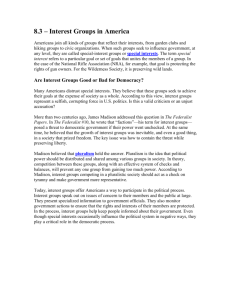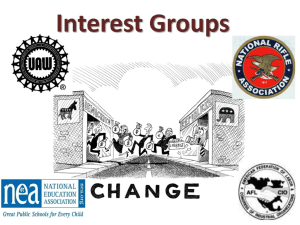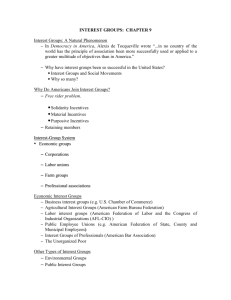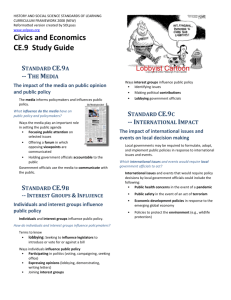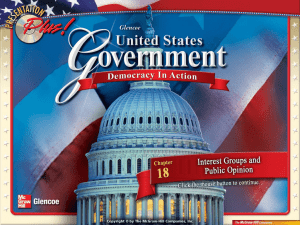Interest Groups in America Americans join all kinds of groups that
advertisement
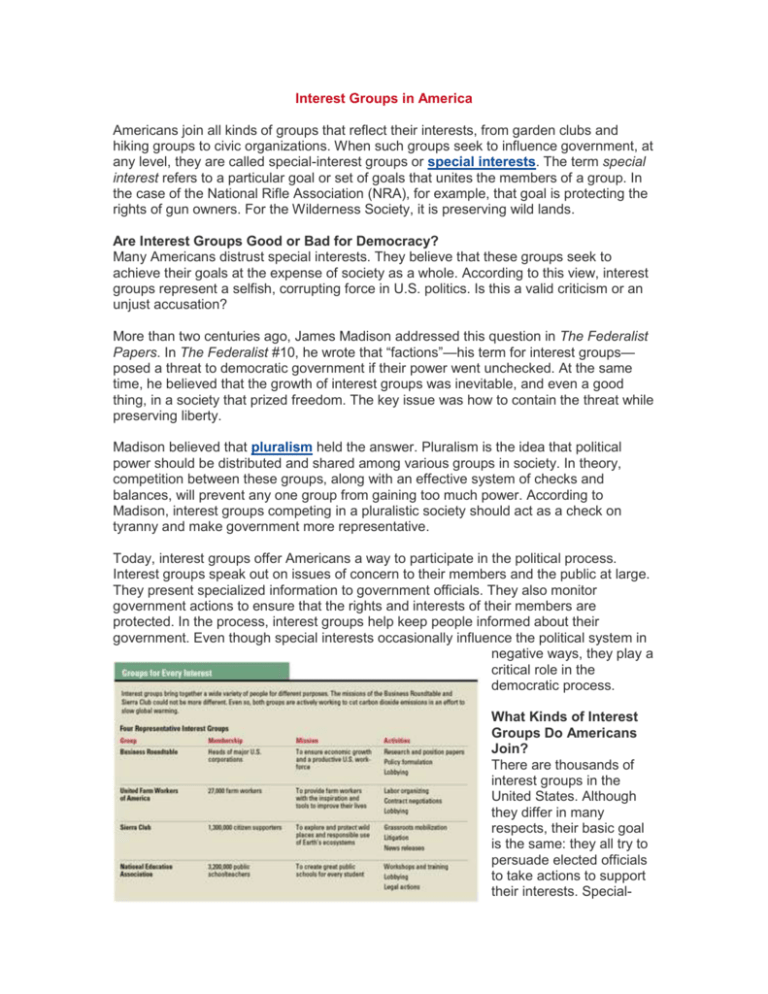
Interest Groups in America Americans join all kinds of groups that reflect their interests, from garden clubs and hiking groups to civic organizations. When such groups seek to influence government, at any level, they are called special-interest groups or special interests. The term special interest refers to a particular goal or set of goals that unites the members of a group. In the case of the National Rifle Association (NRA), for example, that goal is protecting the rights of gun owners. For the Wilderness Society, it is preserving wild lands. Are Interest Groups Good or Bad for Democracy? Many Americans distrust special interests. They believe that these groups seek to achieve their goals at the expense of society as a whole. According to this view, interest groups represent a selfish, corrupting force in U.S. politics. Is this a valid criticism or an unjust accusation? More than two centuries ago, James Madison addressed this question in The Federalist Papers. In The Federalist #10, he wrote that “factions”—his term for interest groups— posed a threat to democratic government if their power went unchecked. At the same time, he believed that the growth of interest groups was inevitable, and even a good thing, in a society that prized freedom. The key issue was how to contain the threat while preserving liberty. Madison believed that pluralism held the answer. Pluralism is the idea that political power should be distributed and shared among various groups in society. In theory, competition between these groups, along with an effective system of checks and balances, will prevent any one group from gaining too much power. According to Madison, interest groups competing in a pluralistic society should act as a check on tyranny and make government more representative. Today, interest groups offer Americans a way to participate in the political process. Interest groups speak out on issues of concern to their members and the public at large. They present specialized information to government officials. They also monitor government actions to ensure that the rights and interests of their members are protected. In the process, interest groups help keep people informed about their government. Even though special interests occasionally influence the political system in negative ways, they play a critical role in the democratic process. What Kinds of Interest Groups Do Americans Join? There are thousands of interest groups in the United States. Although they differ in many respects, their basic goal is the same: they all try to persuade elected officials to take actions to support their interests. Special- interest groups fall into several categories, depending on their membership and goals. The table below highlights four such groups. One of the largest categories consists of economic interest groups. This category includes business groups, trade organizations, professional associations, and labor unions. Examples include the Business Roundtable, the American Medical Association, and the United Farm Workers of America. Another broad category consists of citizen groups, many of which claim to promote the public interest. Some of these groups may also be motivated by a particular ideology or set of issues. Environmental groups, such as the Sierra Club, belong in this category, as does the American Civil Liberties Union (ACLU). Some single-issue groups, such as Students Against Destructive Decisions (SADD), also fit in this category. Government interest groups exist at every level of government. They include groups like the National Governors Association and groups that represent mayors or city managers. Public employee unions, like the National Education Association (NEA), also belong in this group. There are other categories, as well, such as foreign policy interest groups, nationality groups, and religious organizations. At the same time, many special interests, such as the American Legion and the Veterans of Foreign Wars (VFW), do not fall neatly into any particular category. Nonetheless, such groups may be large and highly influential. Why Do People Join Interest Groups? Americans join interest groups for various reasons. Some join for the information and benefits the groups offer. Many interest groups publish newsletters and host workshops and conferences for members. Some offer training that helps members qualify for higher-paying jobs. AARP, formerly the American Association of Retired Persons, an interest group for older Americans, provides information on federal health insurance benefits and prescription drug programs. The American Automobile Association (AAA) offers benefits in the form of emergency towing service and discounts on insurance and travel. Americans also join interest groups because they agree with the group’s goals and want to be part of a larger community of shared interests. The World Wildlife Fund (WWF), for example, attracts people who want to protect animal habitats. Members of the Christian Coalition of America share religious and political beliefs. How Are Interest Groups Organized and Funded? In an essay on democracy, policy analyst Archon Fung called “organized money and organized people” the sources of power in American politics. All interest groups need both money and people, but they are organized and financed in many ways. Most interest groups have an elected board of directors or trustees who set policy and decide how the group’s resources will be used. Many groups have both national and state chapters, each led by their own boards or trustees. Funding methods vary among interest groups. Many economic and single-issue groups get most of their operating expenses from dues, membership fees, and direct mail fundraising campaigns. Some public interest groups get their primary funding from foundations or government grants. The Rise of Political Action Committees One way that interest groups try to influence government is by contributing money to political parties and candidates during election campaigns. Campaign finance laws passed by Congress in the early 1970s placed limits on some types of campaign contributions. But these laws allowed the creation of new funding organizations called political action committees (PACs). PACs are private groups sponsored by corporations, trade associations, unions, or other interest groups. By law, PACs are allowed to collect donations and funnel that money into political campaigns. Most of these donations come from the employees or members of the group that formed the PAC. Over the past decades, the amount of money raised and spent by PACs has grown. In 1980, PACs contributed about $131 million to candidates. By the 2004 election, that figure had risen to more than $310 million. Even adjusting for inflation, that is a substantial increase. Corporations are by far the top contributors to PACs, though many public interest groups, trade associations, and labor unions also make large donations. Many Americans believe that PAC campaign contributions give interest groups too much influence over elected officials. Nevertheless, most research shows that PAC money does not buy votes in Congress. It does, however, give contributors greater access to lawmakers. How Do Interest Groups Influence Policy? Campaign contributions are one way interest groups try to influence government policy. But they have other, more powerful methods as well, such as lobbying, research, litigation, and grassroots mobilization. Lobbying. Many interest groups rely heavily on lobbying to advance their interests. Lobbying is an attempt to influence the policy process by persuading public officials to favor or oppose action on a specific issue. Lobbyists speak to members of Congress and their staffs, testify before congressional committees, and offer comments at hearings held by executive agencies. Often they provide useful information that helps officials create policies that serve the public interest. Senator Edward Kennedy of Massachusetts has noted that lobbyists play a useful role in the political process. “Without lobbying, government could not function,” he said. “The flow of information [from lobbyists] to Congress and to every federal agency is a vital part of our democratic system.” Research and policy proposals. Some interest groups carry out research and write policy proposals that support their goals. In some cases, they work with think tanks to carry out this research. A think tank is an organization of scholars and policy experts who study public issues and write articles and books that summarize their research. Interest groups use these expert findings to influence government officials. Litigation. Interest groups may also try litigation, or the bringing of lawsuits, to influence policy. One interest group that has used litigation effectively is the National Association for the Advancement of Colored People. Lawyers for the NAACP have brought numerous lawsuits to court to advance the cause of civil rights. The NAACP’s most famous victory came in the 1954 Supreme Court case of Brown v. Board of Education, which helped bring an end to segregation in public schools. Grassroots mobilization. Another way interest groups try to influence policy is through grassroots mobilization. Basically, this means rallying strong and vocal support from a large group of people at the local level. Grassroots mobilization often takes the form of public demonstrations, such as antiwar protests or antiabortion rallies. Increasingly, however, it is carried out by mail or over the Internet. Interest groups call on members to write cards or flood the e-mail inboxes of public officials with messages urging a particular course of action. What Makes an Interest Group Powerful? Several factors help interest groups become successful. Size and money are key factors, but other criteria can also play a role. Size and money. Interest groups often succeed when they have a large membership and substantial resources. Interest groups with millions of members can gain the attention of government officials through sheer force of numbers. With ample funds, they can afford to maintain offices around the country, hire a large staff, and pay travel and lobbying expenses. They can also produce expensive media ads to raise their public profile. Unity of purpose. Size and resources matter, but so does the commitment of members to the group’s goals. Small, single-issue, or ideological groups may demonstrate this unity most effectively, because their members tend to be motivated and focused. But even a large, diverse group like AARP can show great unity of purpose. When the members of an interest group voice unified, forceful views on an issue, government leaders tend to listen. Effective leadership. Strong leadership is another critical factor in an interest group’s success. Effective leaders can clearly express the group’s message and win support from others. Without effective leadership, even a group with a powerful message may fail to achieve its goals. Information and expertise. Successful interest groups know how to gather and analyze information and deliver it to decision makers. For example, in the 1970s, Ralph Nader’s interest group Public Citizen used careful research and analysis to convince Congress to pass consumer protection laws that improved car safety. Not surprisingly, large, well-funded groups have a clear advantage in efforts to influence government policy. Nevertheless, many small but dedicated interest groups have also had a notable impact, despite their limited resources.
